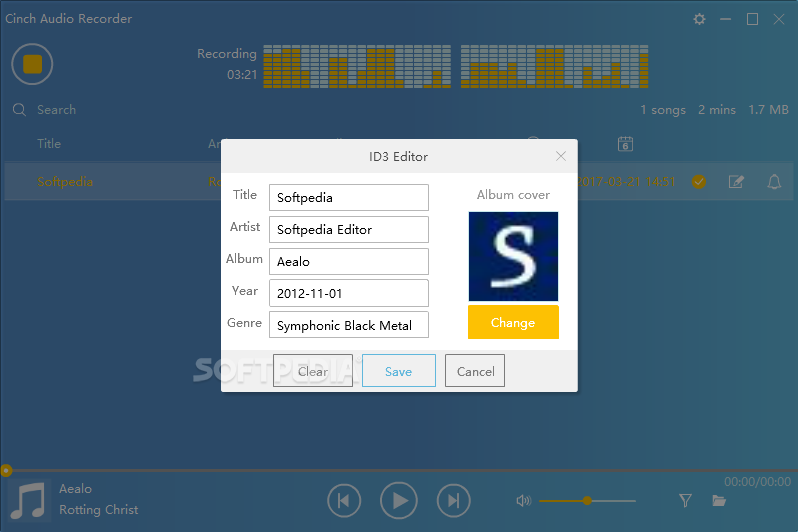
Its made my moring commute almost bearable.An audio tape recorder, also known as a tape deck, tape player or tape machine or simply a tape recorder, is a sound recording and reproduction device that records and plays back sounds usually using magnetic tape for storage. I can fast-forward through comercials and even separate each show into chapters. Thanks to Streaming Audio Recorder, I can listen my favorite onine radio stream anywhere-without the internet. Wondershare Streaming Audio Recorder Review by Dan L.
The recorder makes use of virtual sound card in order to record audio to MP3 or M4A with high quality.It incorporates resembled clarity and sound player include. Though the steps of recording audio are simple but it ensures that you get great audio sounds with high fidelity. Tape-recording devices include the reel-to-reel tape deck and the cassette deck, which uses a cassette for storage.This top-quality audio recorder is a powerful program.
This German invention was the start of a long string of innovations that have led to present-day magnetic tape recordings.Magnetic tape revolutionized both the radio broadcast and music recording industries. Prior to the development of magnetic tape, magnetic wire recorders had successfully demonstrated the concept of magnetic recording, but they never offered audio quality comparable to the other recording and broadcast standards of the time. Furt pcat Dempsey Cinch Audio Recorder Crack 4.0.2 Serial KeyCode (Torrent)The use of magnetic tape for sound recording originated around 1930 in Germany as paper tape with oxide lacquered to it. It way it doesn’t get the most noticeably awful of it sound quality amid recording process.Transparent fizician Dou Cinch Audio Recorder 4.0.2 Crack + KeyCode full. It incorporates HD/HQ sound recording highlight.
The wax strip passed from one eight-inch reel around the periphery of a pulley (with guide flanges) mounted above the V-pulleys on the main vertical shaft, where it came in contact with either its recording or playback stylus. The machine was of sturdy wood and metal construction, and hand-powered by means of a knob fastened to the flywheel. It employed a 3⁄ 16-inch-wide (4.8 mm) strip of wax-covered paper that was coated by dipping it in a solution of beeswax and paraffin and then had one side scraped clean, with the other side allowed to harden. The patent is based on this machine.The earliest known audio tape recorder was a non-magnetic, non-electric version invented by Alexander Graham Bell's Volta Laboratory and patented in 1886 ( U.S. As of the first decade of the 21st century, analog magnetic tape has been largely replaced by digital recording technologies.Prototype of the Goodale tape recorder. The alternative recording technologies of the era, transcription discs and wire recorders, could not provide anywhere near this level of quality and functionality.Since some early refinements improved the fidelity of the reproduced sound, magnetic tape has been the highest quality analog recording medium available.
The tapes and machine created by Bell's associates, examined at one of the Smithsonian Institution's museums, became brittle, and the heavy paper reels warped. While the machine was never developed commercially, it somewhat resembled the modern magnetic tape recorder in its design. Both recording and playback styluses, mounted alternately on the same two posts, could be adjusted vertically so that several recordings could be cut on the same 3⁄ 16-inch-wide (4.8 mm) strip. In playback mode, a dull, loosely mounted stylus, attached to a rubber diaphragm, carried the reproduced sounds through an ear tube to its listener. The sharp recording stylus, actuated by a vibrating mica diaphragm, cut the wax from the strip.

In 1912, a similar process was used for the Hiller talking clock.Photoelectric paper tape recorder In 1932, after six years of developmental work, including a patent application in 1931, Merle Duston, a Detroit radio engineer, created a tape recorder capable of recording both sounds and voice that used a low-cost chemically treated paper tape. The patent description states that the machine could store six records on the same strip of film, side by side, and it was possible to switch between them. The celluloid film was inscribed and played back with a stylus, in a manner similar to the wax cylinders of Edison's gramophone. He received the patent for his invention in 1909.
It is exhibited at Brede works Industrial Museum, Lyngby, Denmark.The first wire recorder was the Telegraphone invented by Valdemar Poulsen in the late 1890s. A playback head can then pick up the changes in magnetic field from the tape and convert it into an electrical signal to be amplified and played back through a loudspeaker.Magnetic wire recorder, invented by Valdemar Poulsen, 1898. An electrical signal, which is analogous to the sound that is to be recorded, is fed to the recording head, inducing a pattern of magnetization similar to the signal. Analog magnetic wire recording, and its successor, magnetic tape recording, involve the use of a magnetizable medium which moves with a constant speed past a recording head. Magnetic recording Magnetic recording was conceived as early as 1878 by the American engineer Oberlin Smith and demonstrated in practice in 1898 by Danish engineer Valdemar Poulsen. The sound track could be immediately replayed from the same recorder unit, which also contained photoelectric sensors, somewhat similar to the various sound-on-film technologies of the era.

A reservoir system containing a loop of tape helped to stabilize the speed. The quality and reliability was slightly improved, though it still tended to be obvious that one was listening to a recording. In September 1932, a new model was installed, using 3 mm tape with a recording time of 32 minutes.In 1933, the Marconi Company purchased the rights to the Blattnerphone, and newly developed Marconi-Stille recorders were installed in the BBC's Maida Vale Studios in March 1935. Though not considered suitable for music the machine continued in use and was moved to Broadcasting House in March 1932, a second machine also being installed.
Rewinding was done at twice the speed of the recording.Despite these drawbacks, the ability to make replayable recordings proved useful, and even with subsequent methods coming into use (direct-cut discs and Philips-Miller optical film the Marconi-Stilles remained in use until the late 1940s. The tape was liable to snap, particularly at joints, which at 1.5 meters/second could rapidly cover the floor with loops of the sharp-edged tape. The reels were heavy and expensive and the steel tape has been described as being like a traveling razor blade. By September there were three recording rooms, each with two machines.They were not easy to handle.



 0 kommentar(er)
0 kommentar(er)
